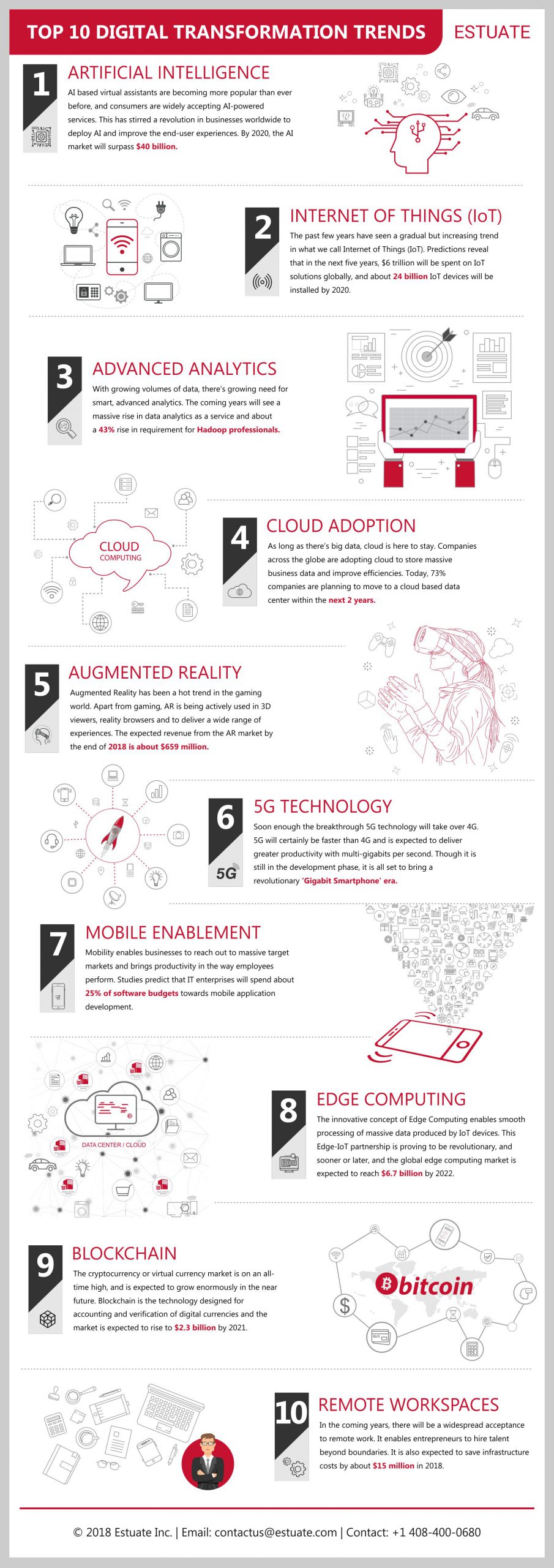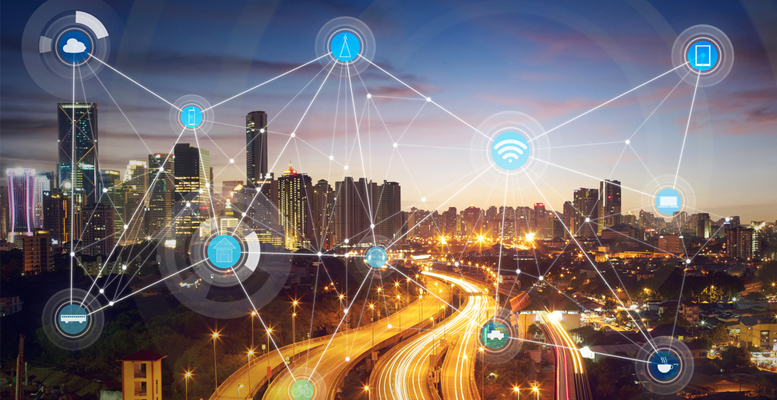Top 5 Digital Transformation Trends in Healthcare – [Infographics]
Watch out the top five digital transformation trends in healthcare.
Watch out the top five digital transformation trends in healthcare.

Mobile technology is a growing business trend. Here are 5 reasons why you must consider adopting mobility in your enterprise.
Mobile phones are an integral part of our daily lives. A research conducted by British psychologists states that an average adult spends roughly 5 hours in a day using his phone.
Thanks to smartphones that come with numerous apps that make life simpler as well as entertaining. From online shopping to food delivery, web maps to mobile banking, and social media to self-healthcare apps, there’s an app for almost everything today.
As much as 269 billion mobile apps were downloaded in 2017. This rapid growth in the mobility sector is inspiring all businesses to embrace mobile technology in some form or the other. In this article, we have listed out the top 5 reasons why all businesses need to enter the world of mobility.
Greater accessibility
This is the era of hand-held devices. As of February 2017, mobile devices accounted for 49.74 percent of internet usage worldwide. Mobility is reshaping the way businesses reach out to customers. Increased mobile data usage is pushing enterprises to think ‘Mobile First’. Mobility ensures that your customers can access your products and services anytime from anywhere. It also enables you as a business to attract potential customers and engage existing customers effectively through interactive apps and mobile responsive sites.
Improved customer service
In a world where customer is the king, businesses are constantly on their toes to offer better customer service and enhance customer relations. Mobility is hugely impacting customer experience in multiple ways. It enables you to offer a personalized shopping experience based on customer purchase histories and preferences. It also facilitates faster and easier troubleshooting with 24X7 customer support. Mobility is turning out to be the foundation of excellent customer engagement.
Renewed marketing strategies
Gone are the days when marketers used to shoot email campaigns to customers only to get spammed later. Mobility is changing the role of marketing. While 65 percent of email is spam, less than 10 percent of SMS is. Traditional marketing methods are being reformed and mobile technology is being used more and more to capture markets and promote products and services. Marketers are using SMS marketing, mobile advertising and social media marketing, changing overall marketing strategies based on target markets.
Enhanced internal communication
In addition to using mobile technology to engage customers and increase sales, businesses are also developing applications and web portals to facilitate internal business communication. It is a great way to establish a strong network across the enterprise. Today, about 60% employees use apps for work-related activities. Whether it’s sharing important business information, or keeping them engaged and ensuring business goals are effectively met, enterprise mobility is now a critical component to improving internal business communications.
Better branding
Mobile technology and mobility tools expose your business to millions of potential customers, leading to improved brand awareness. The more your customers know about you, the more they’re likely to do business with you. The customer always wants more. Having a mobile responsive site, a round-the-clock support mechanism, a well-performing app, are all ways to improve your business brand and get an edge over competitors.
The concept of mobility is exciting because it is technology made portable. In a world where the customer is time-poor, businesses have to go that extra mile to offer convenience. Mobility delivers convenience, flexibility and speed, which is why customers are embracing it in all ways. Have you already entered the world of mobility to improve your business?
In this fast and diverse business world, digitization is leading the way in 2018. If 2017 was a year of trendsetting technology innovations, 2018 has a lot more in store. The worldwide spending on Digital Transformation technologies is expected to be nearly $1.3 trillion this year. This infographic unveils the top 10 digital transformation trends that would make it big in 2018.


Have you been carrying on with your old-school systems for too long? Here’s why you need to modernize your enterprise soon.
Digital transformation is at its peak and it’s becoming more of a necessity than an initiative for all digital enterprises. As much as businesses want to transform digitally and embrace latest technology, it’s not a perfect world.
Almost all businesses carry decades-old legacy systems and disposing off the old school hardware and software can be an overwhelming process.
CIOs often face a dilemma between retaining legacy technology and bringing in latest technology to their enterprise. The question is how far can you take your legacy technology in this competitive, rapidly evolving IT space? If you too are torn between continuing with your aging technology and modernizing your enterprise, here’s why legacy systems are no good for your enterprise anymore.
Businesses running on legacy technology know how frustrating it is when it takes forever to load data in an application, hours to perform simple tasks and ages to generate reports. Regardless of how trustworthy these legacy applications are, they’re not as fast and agile as modern technologies. Moreover, they come with complex structures and manual intervention. With changing times, businesses need to speed up their operations and depending on legacy systems will only cause performance hiccups.
Maintaining legacy systems is a costly affair
CIOs believe that migrating to new technology could be an expensive deal, and hence it’s better to continue with the aging systems. Let’s break the myth here. The truth is, maintaining ancient applications involves greater costs as opposed to replacing them. On average, organizations spend from 60 to 85 percent of their IT budgets maintaining bulky hardware devices, staff training, vendor payments and support costs. So, if you’re thinking you aren’t yet prepared to spend on technology migration, you probably are already spending more than that on maintaining your legacy systems.
They’re incompatible with modern technology
In the modern business world, staying stagnant is not an option. Most mainframe applications are not compatible with new-age tools and software. This lack of flexibility restricts enterprises from being able to catch up with changing times and utilize latest market capabilities. This is a huge setback in terms of customer satisfaction and revenue management. Sticking to rigid legacy systems that fail to integrate with modern technology will put you much behind your competitors in the market.
Cybersecurity threats
Another myth associated with legacy systems is that they’re more immune to cybersecurity breaches compared to modern systems. While modern systems may be more vulnerable to security threats, it does not mean legacy systems are completely safe. Most businesses use mainframe systems for decades and they obviously carry huge sets of historical data, which could be exposed to malicious attacks at any given point in time. In fact, the older your legacy systems, the more they’re vulnerable to malware and security attacks.
Legacy systems do not support mobility
Your customers no longer depend on a desktop to access the internet. They use mobiles, smartphones and tablets to browse products, carry transactions and stay updated. As the need for mobile enablement grows for businesses, it is also imperative that the technology you use supports mobile engagement. Most legacy frameworks do not integrate with mobile technology, hindering mobile enablement for digital enterprises. If you want to catch up with your customers through mobile technology, you must consider migrating to a more modern and mobile platform.
Legacy systems were a thing back then. But today, a new wave of technology has taken over, and enterprises need to keep up with the changing times if they aspire to succeed. While technology modernization could be a very daunting decision to make, it is important to consider the pros and cons of continuing with mainframe systems. The wise option is to keep the ones that are still delivering business benefits, and replace the ones that are not.

Internet of things is leading us to smarter lives. Here are 6 real-world IoT applications that are driving businesses crazy.
Technology is making devices come to life, and we are so loving the concept of Internet of Things (IoT). From hi-tech devices to smart appliances, it’s crazy how IoT is leading us to a smarter lifestyle. A Statista study reveals that in 2015, there were about 15.4 billion connected devices.
This number is expected to grow to 30.7 billion in 2020, and 75.4 billion by 2025. It wouldn’t be a surprise if in a few years we’d start calling it the Internet of Everything.
Just like any other disruptive phenomenon, the IoT market is only going to grow. It opens doors to limitless opportunities and industries are grabbing every possible chance to infuse IoT in their operations.
Check out the top 6 IoT applications that businesses are embracing with open arms.
Smart City Devices
Who doesn’t want to live in a “Smart City”? IoT is transforming cities by connecting urban infrastructures with high performing technology. Parking guidance, traffic monitors, water leakage and waste management detectors are being installed to offer a hi-tech lifestyles to citizens, and manufacturing and IT businesses are leaving no stone unturned to build devices for smart cities. The United Nations estimates that nearly 60 percent of the world’s population will live in smart cities by 2030.
Industrial IoT (IIoT)
Also known as Industrial Internet, the IIoT is rapidly becoming a widely accepted trend in the IT space. IIoT is substantially improving connectivity, efficiency, scalability, time savings, and cost savings for industrial organizations. It combines the smartest of devices, advanced analytics and Machine to Machine (M2M) communications to scale up IT operations. According to an IDC research, the estimated spending on IIoT will scale up to as much as $1.4 trillion by 2021.
eHealthcare
Technology is totally driving the healthcare industry. eHealth trends are reshaping the way healthcare is delivered and experienced globally. Wearable devices, fitness applications, connected inhalers and skin sensors are driving eHealthcare and there are immense possibilities that healthcare enterprises are constantly exploring. 73% of healthcare organizations are already using IoT for monitoring and maintenance of their operations.
Intelligent Logistics
Businesses are discovering the advantages of adopting intelligent logistics and IoT based supply management systems. IoT facilitates warehouse management, fleet management, and enables monitoring the status of assets, parcels, and people in real time throughout the value chain. Studies reveal that the logistics market will experience a 30% growth with IoT enablement.
Connected Automobiles
The consumer markets are prepared for the next big thing, connected cars and automobiles. IoT is bringing advanced features like connected vehicle sensors, fuel tracking, speed control and vehicle usage analytics for smart user experiences. Giants like BMW, Hyundai and Mahindra are making huge investments in IoT to deliver supreme travel experiences to their customers through smart cars and vehicles. About 94 million connected cars are expected to be manufactured and shipped by 2021.
Smart Retail
The retail industry has evolved with IoT technology by its side. From smart shelves to customer engagement applications, inventory management and automated packaging, retail enterprises are using IoT in all possible areas of their operations. 77 percent of retailers see that Internet of Things changes the customer experience and certainly IoT will be used even more widely by retail in the future.
Internet of Things is revolutionary and there are already more objects connected to the internet than people. The global IoT market is expected to grow from $157 billion in 2016 to $457 billion by 2020; which is no surprise at all. With time, it only gets bigger and better. IoT is soon going to be a necessity than a luxury. It’s time businesses make a move towards IoT because this is certainly going to be an IoT era.
Sources:
Statista: Internet of Things (IoT) connected devices installed base worldwide from 2015 to 2025 (in billions)
Soapbox: Where connected cars and IoT are headed in the next five years
Forbes: 2017 Roundup of Internet of Things Forecasts

Modern technology trends are driving a new wave of digitization. Companies around the globe are moving on from traditional, mainframe technologies to faster and smarter new-age tech trends. 2018 was a remarkable year with some groundbreaking technology advancements. While Artificial Intelligence, Cloud and Internet of Things were the most popular digital transformation trends, other emerging technologies such as Blockchain and Machine Learning were widely adopted and explored globally.
The Internet of Things is a sensational technology. Within just a short span of its emergence, the technology has captured global markets and there are as much as 17 billion connected devices in the world today. In 2019, you can only expect the IoT fever to go a notch higher, with smart spaces coming into picture.
A smart space is an environment in which humans and technology-enabled systems interact in increasingly open, connected, coordinated and intelligent ecosystems. It is all about furnishing physical spaces with connected devices, sensors and IoT-driven technology to create smarter and more efficient surroundings.
Mobility is an ever evolving technology that takes a generation leap every few years. Every new generation of mobile technology is faster, smarter and more intelligent than the previous one. The much awaited 5th generation mobile technology is all set to disrupt the world of telecommunications this year.
With innovations like wireless connectivity, extraordinary speed of nearly 1 GBps, powerful latency up to 1 millisecond and numerous other striking specifications, 5G technology is a total game changer, and 2019 is merely the beginning of a revolution in the world of telecommunication, gaming and mobile.
Cybersecurity is a worldwide concern, and digitization at the cost of data privacy is not an acceptable thing. In early 2018, the European Union enforced the iconic GDPR law to protect the data privacy of EU citizens. It has inspired economies across the globes to strengthen their data privacy laws and influenced businesses to rethink the concept of digitization, making data privacy a prerequisite for all digital transformation initiatives.
In 2019 and the years to come, stronger worldwide data privacy laws will govern digital transformation and enterprises are likely to implement tougher and more effective data privacy measures.
Machine Learning, AI and Natural Language Processing have just begun to influence business processes and customer interactions. These are technologies that enable machines to act, think and interact just like humans.
A survey conducted by O’Reilly indicates that 49% companies want to explore and deploy machine driven business practices in 2019. However, despite all the hype around AI and ML technologies, it is still a budding technology and has a long way to go.
Pokemon Go and PUBG became worldwide sensations because of the unique virtual experiences they offer to users. VR and AR technology trends have reshaped the gaming world already.
While Virtual Reality presents a way to enter a virtual world through devices and applications, Augmented Reality adds a virtual element to a physical environment that isn’t actually there. In 2019, VR and AR technologies are all set to redefine several other industries such as training and learning, consumer entertainment and smart automobiles.
In this Information Age, analytics is the real power. It allows enterprises to achieve business goals efficiently and make profitable decisions. Like all technologies, analytics is constantly evolving and setting innovative new trends.
According to Gartner, the future of big data lies in augmented analytics. Augmented Analytics utilizes data produced from digital business systems, such as financial software, HR automation and ERP practices and offers unique and hidden business insights above and beyond general analytics. Although Augmented Analytics is still in its early development stage, it is a promising technology trend and has immense scope for digital enterprises.
This rapid advancement in technology solutions is a blessing for businesses that wish to grow quickly and gain a competitive edge. While some have already started exploring and adopting these recent trends to stay on top of the competition, some are in consideration phase and some are still stuck with old school technology. Nevertheless, the fact remains that digital transformation is not a choice today, it is a business essential and the sooner you make a move, the better it is.